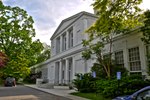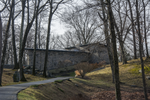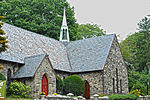Scarborough Historic District
Briarcliff Manor, New YorkBuildings and structures in Westchester County, New YorkGeorgian architecture in New York (state)Historic districts in Westchester County, New YorkHistoric districts on the National Register of Historic Places in New York (state) ... and 7 more
Hudson RiverMid 19th Century Revival architecture in the United StatesNRHP infobox with nocatNational Register of Historic Places in Westchester County, New YorkOssining, New YorkU.S. Route 9Victorian architecture in New York (state)

The Scarborough Historic District is a national historic district located in the suburban community of Scarborough-on-Hudson, in Briarcliff Manor, New York. The 376-acre (152 ha) district was added to the National Register of Historic Places in 1984, and contains seven historically and architecturally significant properties dating from the late 18th century to the early 20th century. Most of the properties are domestic, or used for education or religion. The most common architectural styles within the district are Mid-19th Century Revival and Late Victorian.
Excerpt from the Wikipedia article Scarborough Historic District (License: CC BY-SA 3.0, Authors, Images).Scarborough Historic District
Tower Hill Road,
Geographical coordinates (GPS) Address Nearby Places Show on map
Geographical coordinates (GPS)
| Latitude | Longitude |
|---|---|
| N 41.129166666667 ° | E -73.856111111111 ° |
Address
Tower Hill Road 5
10510
New York, United States
Open on Google Maps










